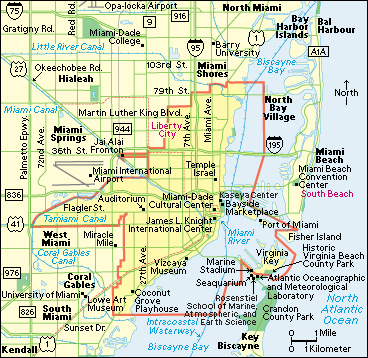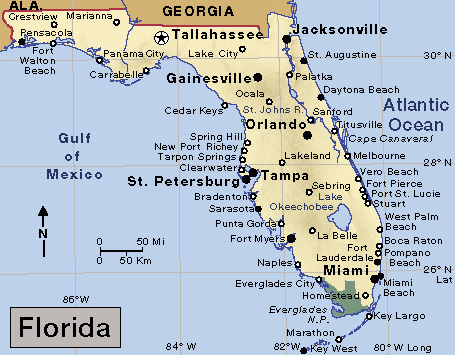Miami, << my AM ee, >> Florida (pop. 442,241; met. area pop. 6,138,333), is a world-famous resort city. Its recreational areas and warm weather attract millions of visitors yearly. Miami is on Florida’s southeast coast at the mouth of the Miami River. The city lies on Biscayne Bay, about 31/2 miles (5.6 kilometers) west of the Atlantic Ocean. Miami is Florida’s second largest city. Only Jacksonville has more people.

The city.
Miami, the county seat of Miami-Dade County, covers about 56 square miles (145 square kilometers), including 20 square miles (52 square kilometers) of inland water. The heart of downtown Miami is the intersection of Miami Avenue and Flagler Street. County government buildings stand nearby.
The Miami-Fort Lauderdale-West Palm Beach metropolitan area consists of Broward, Miami-Dade, and Palm Beach counties. This metropolitan area covers 5,067 square miles (13,123 square kilometers). The Miami-Miami Beach-Kendall metropolitan division, which consists of Miami-Dade County, has a population of 2,701,767.

Over two-thirds of Miami’s population is of Hispanic origin. Cubans make up about half of that group, and they give the city a strong Latin culture. This culture has attracted many banks and companies that handle Latin American trade. The city also has a large Haitian population. Other population groups include those of German, Irish, and Italian descent. Over a tenth of the people in Miami are African Americans.
Economy
of the Miami metropolitan area depends mostly on tourism, which produces billions of dollars annually. The city’s temperature varies little, averaging 84 °F (29 °C) in summer and 70 °F (21 °C) in winter. For the monthly weather in Miami, see Florida (Climate). 
The Miami metropolitan area has thousands of manufacturing plants. The city is one of the largest centers in the country for the production of clothing. Other products include furniture, metal goods, printed materials, and transportation equipment.
Miami International Airport is one of the nation’s busiest terminals. The airport serves as the main air gateway between the United States and Latin America. PortMiami handles passenger and cargo ships from many countries. Passenger trains also serve the city. Leading newspapers published in Miami include Diario Las Américas, El Nuevo Herald, and The Miami Herald.
Education.
A nine-member elected School Board supervises the Miami-Dade County public school system. The Miami area also has hundreds of private and church-supported schools. Institutions of higher learning in the area include Barry University, Florida International University, Florida Memorial University, St. Thomas University, and the University of Miami. The University of Miami’s Rosenstiel School of Marine, Atmospheric, and Earth Science is an important center of ocean study. See Florida International University; Miami, University of.
Cultural life and recreation.
Miami has an opera company and several art galleries, dance companies, and theaters. The downtown Miami-Dade Cultural Center Plaza has the main library and HistoryMiami. Other points of interest in the Miami area include Fairchild Tropical Botanic Garden, Lowe Art Museum, Pérez Art Museum Miami, Zoo Miami, Miami Seaquarium, and Vizcaya Museum and Gardens.
Many visitors come to the Miami area for the Orange Bowl college football game on or near New Year’s Day. The metropolitan area is also the home of the Miami Dolphins of the National Football League, the Miami Marlins National League baseball team, the Miami Heat of the National Basketball Association, the Florida Panthers of the National Hockey League, and Inter Miami FC of Major League Soccer.

Government.
Miami has a mayor-commission government. The voters elect a mayor and five commissioners to four-year terms. The commission appoints a city manager to direct various government services.
Miami is also governed by a metropolitan county government. The 13-member Miami-Dade County Board of Commissioners heads the metropolitan government. It administers pollution control, transportation, and other activities that affect the entire county.
History.
Tequesta Indians lived in what is now the Miami area long before white settlers first arrived. In 1895, Julia D. Tuttle, a Florida pioneer, convinced railroad builder Henry M. Flagler that the area could become rich farmland. She sent him some flowers to show that the land had escaped a killing frost. In 1896, Flagler extended the Florida East Coast Railroad to the area in exchange for land. That same year, Miami was founded and received a city charter. About 1,500 people lived there. The railroad helped Miami’s population reach 5,000 by 1910 and 30,000 by 1920.
During the early 1920’s, a great real estate boom centered in Miami. People made and lost fortunes with the construction of homes, hotels, and resorts. Just as the boom began to decline in 1926, a destructive hurricane struck the city. Another severe storm hit in 1928. Even so, Miami’s population reached 110,000 by 1930.
After the United States entered World War II in 1941, Miami served as an important military training center. The armed services used most of the city’s hotels as barracks. Many service personnel settled in Miami after the war ended in 1945. By 1950, the city had 250,000 people.
After Fidel Castro became dictator of Cuba in 1959, hundreds of thousands of Cubans fled to Miami, about 200 miles (320 kilometers) away. In the late 1970’s, many refugees from Haiti also began settling in the Miami area. See Hispanic Americans (Cuban immigration).
In 1973, Maurice Ferre took office as Miami’s mayor, becoming the first Hispanic mayor of a large U.S. city. Ferre, who was born in Puerto Rico, served as mayor until 1985. That year, he lost a bid for reelection to Xavier L. Suarez, who became the city’s first Cuban-born mayor. Suarez held the office until 1993.
Like many other large cities, Miami faces unemployment and housing shortages, which especially affect the African American population. In 1980, racial tension erupted into violence after four white former county policemen were found not guilty of killing a black Miami businessman. Several other such incidents caused similar unrest during the 1980’s and early 1990’s.
In the mid-1980’s, many new buildings rose in Miami. A rapid transit system, Metrorail, began operating in 1984. Metromover, a downtown monorail line, was added in 1986.
In 1992, Hurricane Andrew hit Florida. Areas south of Miami, especially Homestead, were severely damaged.
In November 1997, Xavier Suarez again won election as mayor, defeating Mayor Joe Carollo. In March 1998, however, a Miami-Dade County circuit judge voided the election because of voter fraud. An appeals court then proclaimed Carollo the winner. Carollo lost in a bid for reelection in 2001.
Miami became the focus of world attention in late 1999 when a controversy erupted over the custody of a 6-year-old Cuban shipwreck survivor, Elian Gonzalez. Elian’s relatives in Miami sought political asylum for the boy. But Elian’s father demanded that the boy be returned to him in Cuba. In April 2000, armed federal agents seized Elian, enforcing a government order that the boy be returned to his father.
In March 2011, voters chose to recall Miami-Dade County Mayor Carlos Alvarez. Alvarez had been mayor since 2004. A local businessman had led a campaign to remove Alvarez from office after the mayor implemented property tax increases and gave his staff pay raises. Alvarez stepped down on March 18, after election results were certified. In June, Carlos Gimenez, a former fire chief, city manager, and county commissioner, was elected mayor.
In 2012, the Marlins baseball team moved into a new stadium in the Little Havana neighborhood just west of downtown.
